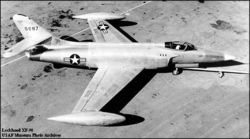PlaneSpottingWorld welcomes all new members! Please gives your ideas at the Terminal.
Lockheed XF-90
| F-90 | |
|---|---|
| Type | Fighter |
| Manufacturer | Lockheed |
| Designed by | Willis Hawkins Clarence Johnson |
| Maiden flight | 1949-06-03 |
| Status | Cancelled |
| Number built | 2 |
| Unit cost | US$5.1 million for the program[1] |
The Lockheed XF-90 was built in response to a U. S. Air Force requirement for a long-range penetration fighter and bomber escort. The same requirement produced the McDonnell XF-88 Voodoo. Lockheed received a contract for two prototype P-90s (later redesignated XF-90). The design was developed by Willis Hawkins and the Skunk Works team under Clarence Johnson. Two prototypes were built (s/n 48-687 and 48-688). Developmental and political difficulties delayed the first flight until June 3, 1949, piloted by Tony LeVier. Performance of the design was considered inadequate, and the XF-90 never entered production.
The first XF-90 used a Westinghouse J-34 engine without an afterburner, while the second had the afterburner installed. The XF-90 was the first USAF jet with an afterburner and the first Lockheed jet to fly supersonic. It also incorporated an unusual vertical stabilizer that could be moved forward and backward for horizontal stabilizer adjustment. Because Lockheed's design proved underpowered, McDonnell's XF-88 won the production contract in September, 1950. Ultimately, that contract was cancelled, although the design was transformed into the successful F-101 Voodoo.
Upon Lockheed's losing the production contract, the two prototypes were retired to other testing roles. The first aircraft (48-687) was shipped to the NACA Laboratory in Cleveland, Ohio in 1953 for structural tests. It was no longer flyable, and its extremely strong airframe was tested to destruction. The other (48-688) survived three atomic blasts at the Frenchman's Flat Nevada Test Site in 1952.
In 2003, the heavily damaged hulk of the second XF-90 (48-688) was recovered from the Nevada test site and moved to the National Museum of the United States Air Force in Dayton, Ohio. It is currently undergoing minor restoration in one of the Museum's restoration facility hangars. Its wings have been removed, and its nose is mangled from the nuclear blasts. During the decontamination process, all the rivets had to be removed to free the plane from radioactive sand. At present, the museum plans to display the plane in its damaged, mostly unrestored condition, to demonstrate the effects of nuclear weaponry.
Specifications (XF-90A)
Template:Aircraft specification
References
- ↑ Knaack MS (1978). Encyclopedia of US Air Force aircraft and missile systems. Office of Air Force History.
- Boyne, Walter J., Beyond the Horizons: The Lockheed Story. St. Martin's Press: New York, 1998.
- Pace, Steve, Lockheed Skunk Works. Motorbooks International: Osceola, WI, 1992.
External link
Related content
Designation sequence
XF-87 -
XF-88 -
F-89 -
XF-90 -
XF-91 -
XF-92 -
YF-93
Related lists
List of Lockheed aircraft
Lists relating to aviation | |
|---|---|
| General | Timeline of aviation · Aircraft · Aircraft manufacturers · Aircraft engines · Aircraft engine manufacturers · Airports · Airlines |
| Military | Air forces · Aircraft weapons · Missiles · Unmanned aerial vehicles (UAVs) · Experimental aircraft |
| Notable incidents and accidents | Military aviation · Airliners · General aviation · Famous aviation-related deaths |
| Records | Flight airspeed record · Flight distance record · Flight altitude record · Flight endurance record · Most produced aircraft |

